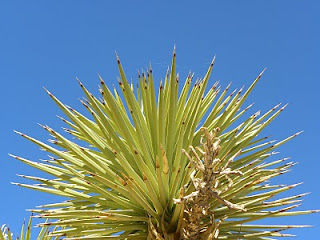Joshua Tree Hugger?
Reviewing the draft environmental impact report (EIR) for the proposed 1,555 acre "Hacienda at Fairview Valley" residential project (for more info, see my previous post), a Joshua Tree survey identified at least 3,891 Joshua Trees on the proposed site. County regulations would require the developer to attempt to avoid impacts to Joshua trees and preserve in-place to the farthest extent possible in order to achieve a “design of excellence.” If the project progresses toward construction, the developer would have to submit a Joshua Tree plan that identifies specific trees to be transplanted or stockpiled for later transplantation or future adoption.
The survey approximated that 38% of the trees on the site would be "transferable," implying that the rest would likely be cut down and discarded. You can download the full report on the website of San Bernardino County's Land Use Services Department in the list of EIRs. Scroll down to the Hacienda project for the "Joshua Tree Survey Report and Management Plan." In terms of Mojave Desert habitat, I'm not sure how prevalent Joshua Tree woodland is, especially since a good portion of woodland likely existed in the higher elevation areas surrounding the San Bernardino and Los Angeles mountains. Since this area is being squeezed by population growth, I am curious to know if woodland regions of the Mojave Desert are particularly imperiled compared to other habitat types, such as creosote scrub areas.

The survey approximated that 38% of the trees on the site would be "transferable," implying that the rest would likely be cut down and discarded. You can download the full report on the website of San Bernardino County's Land Use Services Department in the list of EIRs. Scroll down to the Hacienda project for the "Joshua Tree Survey Report and Management Plan." In terms of Mojave Desert habitat, I'm not sure how prevalent Joshua Tree woodland is, especially since a good portion of woodland likely existed in the higher elevation areas surrounding the San Bernardino and Los Angeles mountains. Since this area is being squeezed by population growth, I am curious to know if woodland regions of the Mojave Desert are particularly imperiled compared to other habitat types, such as creosote scrub areas.
Above: Designed by Mother Nature to tolerate years of drought and extreme temperatures, but the Joshua Tree will be no match for a proposed massive residential development in Apple Valley
Below: A screenshot of the Hacienda at Fairview Valley Joshua Tree density report. Red and yellows are higher desnity and green is lower density Joshua Tree woodland.





Comments
Post a Comment